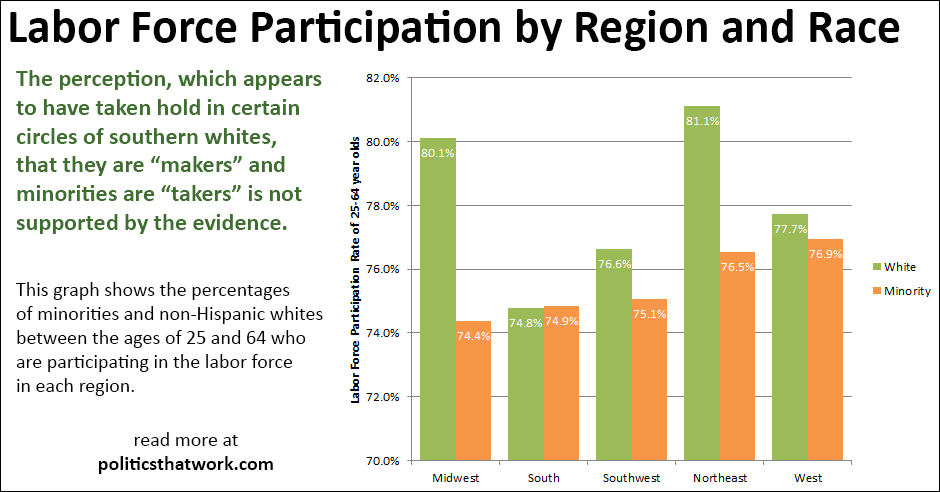
Labor Force Participation by Region and Race (ages 25-64)
Description: The bars represent the percentages of people, in the various groups, who are participating in the labor force. The green bars represent the rates of non-Hispanic whites. The orange bars represent the rates of black, Hispanic and Asian individuals. The bars are split into the five regions of the country.
The labor force participation statistic can be highly misleading. It counts retirees and students as "non-participating" and it looks at all non-institutionalized civilians over the age of 15. That approach results in a much lower number, which can be misleading. To mitigate the distortion caused by differing levels of educational attainment and retirement between the regions, this graph looks only at the labor force participation rate of individuals who are between the ages of 25 and 64, since most education occurs before 25 and most retirement occurs after 65.
Sources: Census B23002H, B23002B, B23002I, B23002D
Data: Excel
Last updated: March 6, 2016
Discussion: The most important thing to take away from this graph is that labor force participation levels do not actually vary all that dramatically either by race or by region. The highest and lowest rates of participation differ by only 7%, which roughly means that the group who works the most (Northeastern whites) work an average of 32 of the years between their 25th and 65th birthdays, while the group with the lowest participation rate (Midwestern minorities) work an average of 29 years during that timeframe. In the big picture, that does not amount to much of a difference. Regardless of where a person lives or what color their skin is, the vast majority of people by and large follow the same pattern- they work from the time they get out of school until they can retire, perhaps with breaks to return to school, raise children or recover from an injury.
The entire premise of "makers" and "takers" does not square with the data. The data shows that there are virtually no "takers" in any meaningful sense. When that myth is wrapped up in race, it is especially damaging. The belief that minorities are "takers" and whites are "makers" appears to have become troublingly common. Many comments to that effect, from politicians, pundits and individuals were made following the 2012 election. That premise appears to undergird much of the voter sentiment that is driving the candidacy of Donald Trump. That belief appears to be particularly common among conservative, southern whites. But, it simply isn't grounded in fact at all. It is especially ironic to hear that idea coming from southern whites, since southern whites work slightly less than southern minorities and significantly less than minorities in the nation as a whole.
See more graphs about: Unemployment Diversity
The entire premise of "makers" and "takers" does not square with the data. The data shows that there are virtually no "takers" in any meaningful sense. When that myth is wrapped up in race, it is especially damaging. The belief that minorities are "takers" and whites are "makers" appears to have become troublingly common. Many comments to that effect, from politicians, pundits and individuals were made following the 2012 election. That premise appears to undergird much of the voter sentiment that is driving the candidacy of Donald Trump. That belief appears to be particularly common among conservative, southern whites. But, it simply isn't grounded in fact at all. It is especially ironic to hear that idea coming from southern whites, since southern whites work slightly less than southern minorities and significantly less than minorities in the nation as a whole.
See more graphs about: Unemployment Diversity
Political and Economic News
EPI: The Tax Cuts and Jobs Act isn’t working and there’s no reason to think that will change
CNN: Trump ordered Mattis to screw Amazon
Elijah Cummings: We are in a fight for the soul of our democracy
Pro Market: The Cost of America’s Oligopoly Problem
...more





